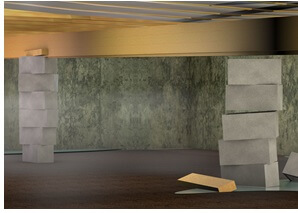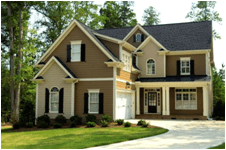More often than not, floors will begin to settle closer to the middle of a home. This is because the perimeter walls are constructed over the foundation and do not settle as much. The support posts or stations located inside the perimeter walls are more susceptible to movement.
A sagging floor in an older or even newer crawl space home is often a sign of a structural problem. If you can see gaps between the floor and baseboards or between the floor and the wall, it is likely that a sagging floor joist is the cause.

House and foundation settling occurs in pier and beam or block and base homes when soil shifts. As expansive clay soils expand and contract underneath the home, it can cause foundation problems that lead to cracks in walls, sagging floors, and other structural issues.
What Causes Floors to Sag or Bounce?
Any crawl space home built atop clay soil can suffer from soil movement that adversely affects the foundation. Clay soils expand when saturated with excessive water and then contract when they dry. This continual swelling and shrinking exert pressure on the foundation, which in turn can cause the piers and support posts to move, resulting in sagging floor joists. This leads to sagging floors and damaged flooring.
Unevenly spaced support pillars can also cause floor joists to sag. When the support pillars are not spaced correctly, the floor joists try to compensate causing the floor to sag and gaps to appear between the floor and wall or baseboards.
Crawl Space Moisture Problems
When the foundation cracks, moisture can enter the home. Moisture can seep into floor joists and weaken them. As a floor joist weakens, the flooring above can sag. Moisture also attracts insects such as centipedes, silverfish, and millipedes.
Other negative effects of moisture include increased energy bills, strange odors, and uncomfortable humidity in the living areas of your home. Excessive moisture can even lead to mold, allowing allergens.

If the floors in your home are sagging, it may be time to consult a repair specialist. Olshan uses the SafeAdjust™ Support Column System to remedy most sagging floor problems. Support columns help provide reliable support beneath the crawl space, resolving the issue of sagging floors. For an even stronger repair, Olshan installs pilings underneath the SafeAdjust™ columns or existing stations to improve structural performance. This service is available as needed.
Depending on the severity of the damage, other repairs such as foundation pilings, drainage and air quality solutions may be recommended in conjunction with Support Columns.
How to Fix a Sagging Crawl Space Floor
For a comprehensive crawl space solution, Olshan offers the CrawlSafe™ System. CrawlSafe™ helps transform the dark, damp underbelly of a crawl space home and convert it into a cleaner, safer space.
CrawlSafe™ includes:
- SafeAdjust™ Support Columns to stabilize sagging floors
- Removing water using our Interior/Exterior Water Management and Waterproofing to improve structural performance over time
- Installing an Air Exchange System such as a crawl space dehumidifier to improve indoor air quality
- Encapsulating the crawl space using moisture-resistant SafeSeal™ liner to deter pests and increase the longevity of the foundation
An Olshan Certified Structural Technician can help determine which products and services are right for your home and long-term home improvement goals. If you are in the Little Rock area be sure to reach out to our team of crawl space & sagging floor experts there!
 Trust Our Foundation Repair Expert:
Trust Our Foundation Repair Expert:

 Trust Our Foundation Repair Expert:
Trust Our Foundation Repair Expert: